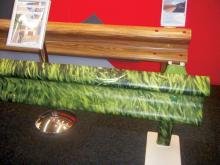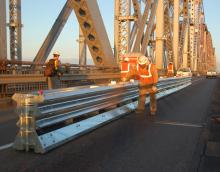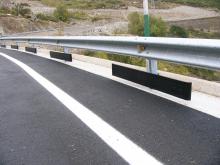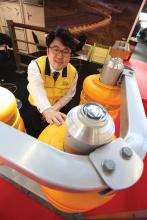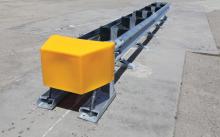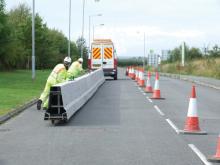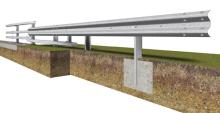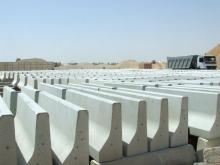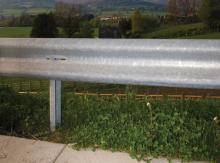RSSA steady flow of new technology and systems is ensuring the highway barrier sector is seeing major gains in safety. Mike Woof reports
A combination of technological development and tougher regulations are ensuring a constant flow of new safety barrier solutions for the highway sector. Issues such as containment and deflection are high on the technical agenda, while a wide array of technologies is being developed to meet specific needs for certain applications.
Both in the US and Europe, an increased focus on highway safety has driven the market, encouraging the major players to develop new barrier concepts. The technology for absorbing impacts and redirecting vehicles back into the carriageway has improved considerably following years of development and ensuring that highways equipped with barriers are safer for the occupants of many vehicle types. In the past these technical advances have been focussed on the needs of the majority of road users in commonplace duties. But manufacturers are also now looking at solutions that will bring safety to vulnerable road users, as well as better products for specific applications such as end treatments, bridge parapets and temporary barriers.
A major problem with many existing barrier installations though is that vehicle restraint systems have been regarded as individual products with little consideration to their interaction with each other, according to Tony Everitt, managing director of leading UK-based supplier
3754 Varley and Gulliver. He explained that bridge parapets are generally erected on the edge of a bridge structure in order to prevent a wayward vehicle from leaving the bridge and falling below. Safety fences on the other hand are placed either on the central reserve to prevent vehicles crossing over from one carriageway, or on the verges to stop vehicles leaving the road and moving into bridge piers, roadside furniture or trees. On the approach to a bridge structure, safety fences are required to be connected to the parapets. The safety fences used under the British standard were either too soft resulting in the vehicle running along the deflected fence and impacting the parapet end with disastrous results, or the safety fence was too stiff with consequential high Accident Severity Indices levels, resulting in excessive forces that could potentially cause severe injury.
The European standard EN 1317 calls for a transition where the interface between two safety barriers have a different cross section or lateral stiffness and that the containment must be continuous.
0 Hill and Smith and its sister company Varley and Gulliver developed the Tranzflex transition to provide a solution from road-way to bridge-way. The system features gradually closing post spacings and strengthens as it approaches the parapet, guiding the vehicle in a safe and controlled manner. Similar to Flexbeam it can be installed with driven posts, eliminating the need for expensive concrete foundations (unless otherwise required) as needed on the older non-EN1317 approved systems. With an ASI value of 1.2 the Tranzflex N2 containment transition provides a high level of occupant safety as well as a W2 working width for greater safety.
Tougher European standards are now being set. The National Roads Authority in Eire requires that all transitions shall be connected to the same safety barrier and parapet system to which they were tested. A transition is potentially more complicated than a parapet or safety barrier as it requires variable stiffness along its length and connects two tested systems, which typically function in a different way. So to ensure total safety on the road network, only systems that have been fully tested (not simulated) together should be considered.
Bridge work
High safety standards are claimed for the new barrier range from Italian specialist
2848 Fracasso. The new bridge barrier offers low deformation performance and meets the tough requirements of the H4B specification in the European EN1317 rating system. Despite the durable structure of the bridge barrier product, it is also light in construction however, due to ITS innovative design. According to Fracasso, the new barriers are designed to be strong and durable as well as to minimise deformation. According to the firm the issue of deformation is increasingly for the European market and in Germany in particular.
The new product range has been designed to reduce installation time and uses bars held in place by three mounting bolts because this is faster to install. The bars are up to 12m long and reduce the numbers of bolts and connectors required compared with conventional systems according to the company. The beam sections that Fracasso uses on the range are 4m long and use steel that is 3mm thick as standard, making them strong and durable. In addition, the firm is also offering new double and single sided barriers that meet the H2 requirements and share a common design philosophy.
Barrier manufacturer
3756 Imeva says ITS new bridge product offers high performance at a competitive price. The H2 product meets the EN1317 barrier requirements and has been successfully crash tested using both buses and cars. According to Imeva, the system delivers a very low deflection while minimising impact forces on the occupants of any vehicle colliding with the barrier. Even after an impact, the car can still be driven. The only deformation that occurs is within the specially designed spacer units and on the steel beams that are hit by the impacting vehicle while the support posts are unharmed. This means only the spacers and beam sections have to be replaced, reducing the lifetime cost of the system. In addition, the beam sections are made from 2mm thick steel compared with the thicker beams used by competing manufacturers, a factor that further reduces installation costs.
A high containment system from
238 Industrias Duero in Spain meets the H2 requirement for EN1317 and is designed for use around bridge pillars to prevent serious accidents, while this system can also be used to protect other vulnerable areas such as transitions, arches and high embankments. German company Volkmann & Rossbach is also offering both high containment (H2) and very high containment (H4b) barriers for similar applications, as well as for bridge parapets.
Amongst the array of high performance barrier products from Norwegian company
7063 SafeRoad is a novel system aimed at bridge parapet applications. Although made from steel like other conventional products, the SafeRoad system features tubular section barrier sections. This system can be selected in an array of specifications, all of which meet the EN1317 requirement, to suit the application. The company says ITS barriers are available in sections up to 12m long and offer high protection capabilities for road users along with long working life even in corrosive environments due to a combination of hot dip galvanising and powder coating.
Meanwhile Indian firm Thakkarsons Roll Forming, part of the
3757 Thakkar group, is offering a range of proven, conventional steel barriers. Various W beam and Thrie beam versions are available to suit duties on bridges, as well as highways and flyovers and the design of these has been based on the guidelines issued by India's Ministry of Surface Transport (MOST). However the barriers also meet international specifications such as the AASHTO M180.
Temporary solution
The issue of safety for workzones or for other temporary purposes has been addressed by many manufacturers with a wide range of products now available. New systems are still coming to market however and an innovative plastic barrier solution is now available in Europe from UK firm
3752 Border Barriers. A wide range of these plastic units are offered to suit an array of safety and security requirements for temporary barriers that can be installed quickly. The firm's Rhino barriers have been tested to meet EN1317 requirements and have been well proven in the UK on an array of construction sites as well as in security applications.
However the firm is now looking to broaden its market and has already received interest from a major German contractor according to Phillip Armstrong, director of the firm. The units are made from polyurethane, which makes them 100% recyclable and these are light to transport, reducing costs in comparison with conventional steel or concrete temporary barrier products. Armstrong said that up to 108 of the Rhino barriers can be carried on a single truck load, as the units are filled with water to provide sufficient weight when installed on-site. He said, "It's easy to deploy and we can have 216 standard Rhino barriers installed and water-filled within two hours, or 148m of the restraint Rhino barriers in two hours." Because the units are lightweight, they are also safer to load and unload while the water-filled design ensures that they are safe and provide an effective shock-absorbing solution according to Armstrong.
French company
3753 Somaro is also offering an innovative solution in the shape of its special inflatable barrier. This has been developed by SOMARO subsidiary Sodirel and is a new concept for closing a road or highway in a few seconds. Marc Gérin, managing director of Sodirel, explained that the barrier is made of fabrics which do not pose a danger to road users. A sequence of barriers can be installed on either a metal guardrail or New Jersey-type concrete barrier and they can be manually or automatically operated. The device is used after an accident, for easier emergency intervention or even maintenance operations. SOMARO says that the barriers will protect maintenance staff and help reduce traffic jams after an accident.
A new temporary barrier system from
2580 Tubosider will help improve safety for highway workers and road users alike. According to Tubosider, this meets a vital need for the highway sector by providing a positive safety zone in roadworks as well as reducing traffic flow problems for road users. This modular steel safety system is designed to separate carriageways and is designed for fast deployment, using a small purpose-built machine. There are two versions available, a model made completely of steel that meets the N2 requirement of the European EN1317 requirement and an H1 variant that features a concrete footing that increases the mass of the system.
The system is innovative as the machine can remove the barrier even when traffic is flowing. This relatively compact piece of equipment is able to deploy the barrier quickly. Because the barrier is made from steel it is lighter than other temporary barrier solutions, which makes it more economical to handle and transport. The system is said to allow work zones to be changed quickly, according to traffic needs.
The high containment BarrierGuard 800 product from
1529 Highway Care has recently been deployed along a busy stretch of the M27 in the UK, between Junction 11 and 12 on both sides of the motorway. The BarrierGuard 800 steel safety barrier is specifically designed for use in road works on high speed roads and was selected by contractor
2319 Costain for its low deflection. Within four shifts over 6km of barrier was installed and the low deflection performance allowed the contractor greater working space and suitable lane widths for the narrow lane set up.
Currently the M27 is undergoing major reconstruction between Junction 11 and 12, by Costain, working on behalf of the
2309 Highways Agency (client) and Owen Williams (designer). The motorway is being upgraded and widened on both sides to include a crawler lane along the westbound carriageway. With BarrierGuard 800 in place, positive protection is provided to both the workforce and passing motorists while the M27 is being widened. The BarrierGuard 800 meets the requirements of both EN1317 - 2 (containment levels N2 and H2) and NCHRP 350 (TL 4).
Volkmann & Rossbach has an array of its Super Rail products aimed at applications in temporary workzone protection. These meet high protection standards and comply with the EN1317 requirements, with an array of solutions available to suit most applications.
End solutions
High return on investment and high performance are key features claimed by
2583 Quixote Transportation Safety (QTS) for its REACT 350 crash attenuator. This new system is designed to be fully self-restoring and can sustain multiple TL-3 impacts without need for repair or re-setting and has passed multiple impact NCHRP 350 testing requirements.
QTS says that the extensive testing procedures have highlighted the ability of the REACT 350 to meet NCHRP TL-3 levels as a self-restoring unit. These tests showed the system was able to handle three impacts, two by a 2tonne pick-up truck travelling at 100 km/h, and the other by a small vehicle weighing 820kg. According to the firm, the tests show that the REACT 350 can cope Double-sided solution
Hill & Smith is broadening its BRIFEN wire rope barrier range with the addition of a double-sided system, aimed at use in central reservation or median installations. The new Bri-Flex double sided vehicle restraint system has been fully tested and meets the needs of the European EN1317 standard, with an H2 rating. The product is designed to suit the W4 working width classification (it has a working width of just 835mm) and tests show that it meets the W5 vehicle intrusion rating. The company claims that tests and experience show that Bri-Flex achieves a class A impact severity level, effectively reducing the forces exerted on anyone inside a passenger car, truck or bus in the event of a collision. The new system is based on proven technology and is a hybrid of the H1/H2 Flexbeam PLUS and Brifen wire rope technologies.with three TL-3 impacts without need for repair or any type of resetting or restoration, providing high secondary impact protection. Because the system is 100% reusable after such impacts, it offers important benefits in terms of low maintenance and costs.
The REACT 350 attenuator features cylinders made of HMW/HDPE plastic and these can regain 90% of their original shape and performance without maintenance or repair of major components after an impact from a vehicle within the specified capacity limits. The cylinders can be attached to a self-contained back-up or to either new or existing concrete-mounted back-up systems. In addition, these barriers also have features including non-gating, re-directive performance and meets TL-1 (50km/h), TL-2 (70km/h) and TL-3 (100 km/h) requirements.
333 Snoline and
165 Barrier Systems are offering a combined safety barrier range, now that they are both owned by US firm
2438 Lindsay Manufacturing. The tie up between the two firms has also allowed the two firms to develop a technology and marketing partnership. Based on this partnership, Snoline plans to launch a new barrier end treatment for the European market that has been developed from a proven US product developed by Barrier Systems. At the same time, Barrier Systems is working on some of the Snoline range so that the units can be marketed in the US.
The original US market version of the end treatment from Barrier Systems features cables that help redirect the vehicle but on the new European model developed by Snoline, the cables are used to absorb the impact forces. Snoline explained that to meet the European requirements the unit now has an additional cable retention feature. Steel guides are used to hold the cables in place, with redirection provided by the lateral barrier.
Fast installation
Installing barriers quickly can reduce cost significantly as this minimises the time that highway workers need to be on-site and for personnel protection measures and lane closures to be needed. Italian company
296 Orteco is offering a cost-effective solution in the shape of its crawler-mounted post installation machine. Power comes from a Hatz diesel rated at 24kW and the 2.5tonne machine offers a 2tonne load capacity, allowing it to carry sufficient posts and guardrail sections for long stretches of barrier and this can be further increased by 400m attaching a wheeled trailer. For fast support pole installation, it features a drill unit that is based on Orteco's proven pile driver technology. The machine is highly computerised and offers a high degree of automation, with manual control through a remote unit. According to Orteco's general manager, Sergio Tassinari, the machine can speed up barrier installation processes considerably and provides rapid payback time for the customer.
RSS


